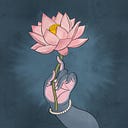Doḷa Purṇimā
At the Puri Jagannath temple, Jagannātha is worshipped as “Doḷa Govinda” on Holi.
According to the Skanda Purāṇa:
“In the month of Phālguna the devotee should celebrate the excellent festival of the swing, wherein Govinda plays and sports for the purpose of blessing the worlds.”
“A replica is made of Jagannātha and named Govinda, who is Puruṣottama himself and should be placed in a bejewelled elaborate swing in order to recreate the scene of Vṛndāvana and Kṛṣṇa’s playing Holi and colour with Gopīs. The festival should be celebrated with playing of different kinds of musical instruments, blowing of conch-shells, shouts of victory, songs, hymns, and showers of flowers. The devotees should scatter fragrant sandal powder all round in all the quarters. Govinda should be worshipped with various offerings and services. The devotee should imagine the Lord of the universe as being positioned in the middle of cowherd lasses at the root of a Kadaṃba tree — the Lord who went on sporting with graceful charms, who was carried in a vehicle drawn playfully by gopis and gopikas. Thinking of Jagannātha thus, he should scatter scented powder powders of red, yellow and white colours along with camphor. The Lord should be adorned and adored with divine robes, divine garlands, divine scents, excellent incense etc. Chowries should be waved to and fro. The Lord in the swing should be slowly swung seven times. Those who see Kṛṣṇa then shall undoubtedly attain salvation. The five sins such as that of the killing of a Brāhmaṇa shall be destroyed.”
At the time of the Purāṇa, there was no permanent structure for the Doḷa Yātrā. The present Doḷa mandapa was built in the 16th century by King Rāmacandra Deva I (1568–1607 AD) who is aptly designated as ‘Dvitīya Indradyumna’ for he reinstalled the idols of Jagannath, Balabhadra and Subhadra in the Puri Jagannath temple which were burnt during Afghan invasion of Odisha. It is said that the King himself stood near the Jaya Vijaya Dvāra and distributed Mahaprasada to the devotees.
______________________________________________________________
If you find value in my work, I hope you consider becoming a patron through Patreon. Hindu Aesthetic requires a lot of time and effort and your support would mean that I can continue bringing you the highest quality content. Link to my Patreon:
